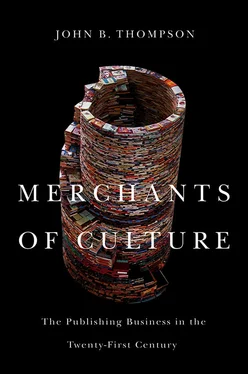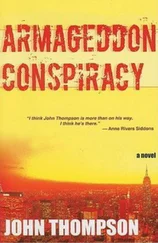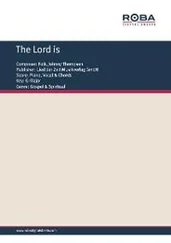Table 2shows the market share of the major US retailers for the sales of two bestselling novels by a leading commercial fiction writer. One book was published in 2005 and the other in 2008; the figures are based on sales of the hardcover edition during the first three weeks after publication. While the market shares for each account vary somewhat from one book to the next, the overall pattern is clear: Costco is the single largest account, with a 21 per cent market share for the 2005 book and 18.7 per cent for the 2008 book; Wal-Mart and Sam’s (which is owned by Wal-Mart) are among the next most important accounts, with market shares of 15.8 and 18.2 per cent in the case of Wal-Mart and 17 and 11 per cent in the case of Sam’s. Taken together, the mass merchandisers (including Target) account for over half of the sales of these books during the first three weeks of sale – 61.3 per cent in 2005 and 53.8 per cent in 2008. Barnes & Noble’s market share was 13 per cent in 2005 and 15 per cent in 2008, while Borders had 8 and 11 per cent. Taken together, the book superstore chains accounted for roughly a quarter of the sales (21 per cent in 2005 and 26 per cent in 2008). Amazon’s share grew from 2.9 per cent in 2005 to 5.4 per cent in 2008. These seven accounts – four of the key mass merchandisers, the two book superstore chains and Amazon – accounted for 85 per cent of the sales of these bestselling hardcover books during the first three weeks after publication. All remaining outlets – including the remaining chains such as Books-A-Million and all the independent bookstores taken together – accounted for only 15 per cent of sales.
Table 2Market share of major accounts for two commercial bestsellers
Hardcover sales for the first three weeks after publication.
|
Market share (%) |
| 2005 novel |
2008 novel |
| Barnes & Noble |
13 |
15 |
| Borders |
8 |
11 |
| Costco |
21 |
18.7 |
| Wal-Mart |
15.8 |
18.2 |
| Sam’s |
17 |
11 |
| Target |
7.5 |
5.9 |
| Amazon |
2.9 |
5.4 |
The sales pattern illustrated by these two books is particular to this type of book – that is, a commercial bestselling novel by a brand-name author, released initially in hardcover. For other types of book – for a work of literary fiction, for instance, or a biography or serious work of non-fiction – the distribution of sales by channel would be very different: Barnes & Noble, Borders, Amazon and the independents would account for a larger share, while the mass merchandisers would have a much smaller share (and, for most books, no share at all). The sales pattern by channel varies greatly from one category of book to another, one format to another, one author to another and, indeed, one book to another. The sales distribution also varies by type and format of book from one mass merchandiser to another, reflecting in part the different demographic profiles of their customers. For example, Wal-Mart tends to do better with commercial fiction in hardcover and mass-market paperback, whereas Target, with its more affluent customer base, tends to do better with trade paperbacks. The mass merchandisers offer a very limited range of bestselling books, carefully selected for their customers. They discount heavily, sometimes by as much as 43 per cent – charging, say, $15.95 for a hardcover with a list price of $27.95. Other retailers, including the book superstore chains, find it difficult to match these prices. ‘The clubs, and Wal-Mart and Target, stole the bestseller business from the superstore chains, just as the chains had stolen the bestseller business from the independents before that,’ explained the sales analyst. ‘And they did it because of discounting, which is exactly how the chains stole it from the independents.’ Margins are wafer-thin, but the mass merchandisers are able to make books profitable by keeping their overheads to a minimum and by achieving high sales volume. The books are often stacked on pallets or tables and are kept in stock only as long as they are selling at a certain rate – typically, for one major wholesale club, at least 1,800 copies a week for new hardcovers. Books that are selling more slowly than this are returned to clear the space for other titles. Hence the return rates from the mass merchandisers tend to be high – generally around 50 per cent, but returns can be as high as 80 per cent for some books. This is a high-volume, low-margin business where the sales opportunities are great – the mass merchandisers can shift large numbers of books – but the risks in terms of returns are also much higher than they are in other retail channels.
The dramatic changes in the marketplace over the last 40–50 years have produced a retail landscape that is a far cry from the array of independent bookstores, department stores and other outlets where books were sold in the 1950s and before. Table 3provides an estimate of the retail book market in the US in 2006, broken down by channel. The superstores and book chains accounted for about 45 per cent of the $12.4 billion retail book market, while the independents accounted for around 13 per cent. 23 Online retailers accounted for around 11 per cent of the market, with book clubs and mail order accounting for another 10 per cent. Other outlets, including the mass merchandisers and warehouse clubs, probably accounted for around 5 per cent overall, although on certain bestselling titles their market share would have been much higher, as we have seen. This is a marketplace in which, over a period of some 40 years, there has been a dramatic shift of market share from a plethora of independent booksellers and stores (whether drugstores or department stores) to large retail chains – first the mall store chains, then the superstore chains and now the mass merchandisers and wholesale club chains – and to online retailers (especially Amazon). It is a shift in which a handful of major retailers – Barnes & Noble, Borders, Amazon and, for certain kinds of bestsellers, Costco, Wal-Mart, Target and Sam’s – emerged as the key customers for publishers and as key players in the struggle to gain visibility for books and bring them to the attention of consumers in an increasingly crowded marketplace. This small set of key retailers has come to wield enormous power in the field of trade publishing, since publishers do not sell directly to consumers but depend increasingly on these retail giants to make their books available to consumers and encourage them to buy.
Table 3Estimated shares of US book retail market, 2006
Sales data from Book Industry Study Group; book sales only (excluding music, magazines, gifts, stationery, cafés, etc.).
Source : Stephanie Oda and Glenn Sanislo, The Subtext 2007–2008 Perspective on Book Publishing (Darien, Conn.: Open Book, 2007), p. 64.
|
Percentage |
Estimated dollars in millions |
| Superstores/chains |
45 |
5,571 |
| Libraries, schools |
16 |
1,980 |
| Independents |
13 |
1,609 |
| Internet |
11 |
1,362 |
| Bookclubs/mail order |
10 |
1,238 |
| Other (mass merchandisers, wholesale clubs, drugstores, etc.) |
5 |
619 |
| Total |
|
$ 12,380 |
The peculiarities of the British
The transformation of the retail landscape in the United States was mirrored by similar changes in the UK; most of the players were different, some of the customary practices were peculiarly British and the consequences were in some respects more radical, but the overall pattern was the same. For most of the twentieth century, the British book trade had been regulated by the Net Book Agreement – an informal arrangement between publishers and booksellers that had been proposed by Macmillan in the 1890s following a period of turmoil and intensive price competition in the publishing industry. 24 The Agreement was based on the idea that publishers would set a fixed or ‘net’ retail price for each book they published; booksellers would agree to sell the books at the net price in return for a discount that would enable them to make a reasonable margin. Any bookseller who broke the rules would not be supplied on trade terms by the publishers. The Agreement came into force on 1 January 1900 and remained in place for nearly the whole of the twentieth century, creating a relatively stable commercial environment for publishers and booksellers.
Читать дальше












